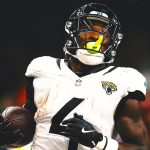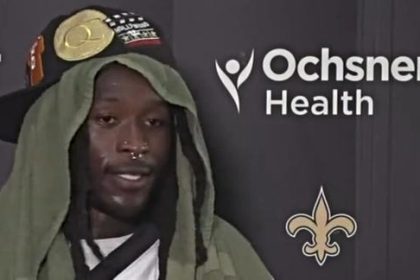It’s not your imagination: NBA offenses are purring at an all-time high, fueled by nightly individual statistical lines that seem almost cartoonish.
If the current league-wide offensive rating on Basketball Reference of 113.6 holds, it will be the highest since they concocted offensive ratings. And those solo gigs? A player has put up 50 or more points in a game 14 times so far this year … with three months to go.
The number of 50-point-plus performances in the entire 2012-13 season? Three.
I asked members of every faction of the league — GMs, executives, coaches, scouts and players — a simple question: Why?
The list of answers is deep and varied.
A rise in offensive skills overall, particularly among the league’s biggest stars. A notably young group of officials who are more inclined to favor the aforementioned stars. Rules that favor the offense, such as the newly instituted penalty for take fouls and flagrant fouls for encroaching on a shooter’s landing space.
All the above, though, points to one common denominator: It’s what the league wants. As competition for consumers and corporate sponsors becomes ever fiercer, the urge to up the entertainment value becomes ever more apparent.
“The league is supporting more scoring now,” said Phoenix Suns guard Damion Lee. “Which isn’t a bad thing, because what’s the thing that’s going to drive bigger ratings and more excitement? You want less stoppage time. Score, get the ball out, go. (Nikola) Jokić had a triple double and only took five shots in a win. That didn’t get much buzz … but then someone (Jalen Brunson) had 44 in a loss and everyone was like, ‘Look at that!'”
The shift has been a work in progress over several seasons. Rosters have been gradually culled of defensive specialists, perimeter stoppers and rim protectors — the Chuck Hayes, Tony Allen, Dikembe Mutombo and Ben Wallace types. Enjoy Rudy Gobert and PJ Tucker while you can — they’re the last of a dying breed. They’re being replaced by players like Lee, a 6-foot-5 shooting guard who nearly takes four 3s a game (3.7), nearly makes half of them (47.7%) and has solid enough handles to get to the paint to draw fouls.
The Suns were missing most of their stars facing the Warriors earlier this week, but Lee cleverly enacted the same strategy against his former team: hit a couple early 3s (2-for-2 in the first quarter) and then attack the closing-out defenders to draw fouls and free throws. Against his former team, Lee scored a season-high 20 points off a career-high 14-for-14 from the line, contributing to an upset win.
“Guys are smart,” said Warriors guard Donte DiVincenzo, who had an up-close look at Lee’s heroics. “They know if they can score on you, and you’re going to get more physical, then when I go over the screen, they’re just going to stop and make me run into them. Or if they’re going to the basket, they’re going to hit you first and then go the other way, and you’re going to overreact. It’s just the way the game is being called. The physicality is being taken out of the game, but smart offensive players know how to create that contact.”
Suns forward Mikal Bridges, one of the best perimeter defenders in the league, admits that the current rules favor offensive players, but he also acknowledged that the scoring versatility of the league’s top players has evolved. Every top scoring star in the league — Luka Dončić, Jayson Tatum, Steph Curry, Kevin Durant, Joel Embiid, Giannis Antetokounmpo — has the ability to score from either a multitude of ranges, angles or both, resulting in either a basket or a foul … or both.
“Steph can shoot the lights out, has a crazy handle and is quick,” Bridges said. “And if you touch him, it’s a foul. Tough to guard that. I know the refs may not officiate the game as great, but you still have to give credit to the guys who are really nice and make it hard for guys like me to guard.”
An Eastern Conference scout put it more bluntly: “You can’t touch anyone on defense, especially the stars, so they are playing H-O-R-S-E. There are so many inexperienced referees who anticipate calls and give the benefit of the doubt to the stars. And that means more free-throw attempts for the best players.”
Head coaches, in turn, have recognized the favorable treatment and are finding ways to funnel the ball to their stars.
“Teams are becoming savvier about allocating possessions to their most efficient players more and more,” said another Eastern Conference scout.
The increasing emphasis on offense is reflected in the pay hierarchy. For the 1990-91 season, the top three highest-paid players were all shot-blocking centers: Hakeem Olajuwon, Patrick Ewing and Hot Rod Williams. All three could score, but their paychecks were based as much on their defensive presence as their offense. Compare that to the top six highest-paid players this season: Curry, Russell Westbrook, LeBron James, Durant, Bradley Beal and Damian Lillard. No centers or shot blockers, or, at this point in their careers, anyone particularly adept on defense.
A former player-turned-scout also points to player empowerment, which he believes has created a shift in the players’ general mindset.
“It’s all about players being happy and what makes them happy is offense,” he said.
“Changing the rules on defense, especially, makes guys say, ‘Well, f— this, it’s pretty much impossible to stop anyone. I mean, you have to play close to perfect defense at all times. There’s no pride in that anymore, just offense. If you score 140, and I score 142, I am better than you. That is the mentality.”
The aggression has shifted to hunting shots, particularly from beyond the arc. The definition of an ill-advised 3-pointer has been dramatically altered, said Suns guard Landry Shamet.
“There’s never a question whether a catch-and-shoot 3 or a 3-pointer in general is a good or bad shot,” Shamet said. “It’s always a good shot. So that alone, player confidence-wise, gives you and your whole team a different mindset. That alone gives you the capability to score a lot of points.”
And then there’s the competitive nature of the top stars.
“Players chase players,” a Western Conference scout said. “[Donovan Mitchell’s] 71 points will be eclipsed this season. There will be someone on a hot shooting night who decides to chase the number. Tatum, Dončić, (Ja) Morant, Steph or (Devin) Booker. Efficient shot-makers with high usage rates, not dependent on others to set them up.”
Lee agreed. “I don’t know if that’s happening in every locker room but for sure, before games, especially being on the West Coast, we see what guys do on the East Coast before our games start.”
The downside, of course, is that the historical significance of reaching such marks is devalued. Games are being played at a pace not seen since the ‘80s, with an ever-growing number of 3-point shots being launched and rule interpretations that make contesting those shots a precarious assignment.
In the 2000-01 season, being a 20-point scorer was fairly elite company — 19 players achieved it. As of right now, that number has more than doubled. Case in point: James averaging 29 points a game at age 38 is impressive. That would be the fifth-highest single-season average of his 20-year career. It’s just less so when you consider seven players right now are averaging more.
Thirty is the new 25.
“Offensive records are being devalued,” the Western Conference scout said. “The NBA has tilted the offense-defense balance. We have become a shooters’ and offensive league.”
Referring to the 1988 musical comedy starring Geena Davis and Jim Carrey, he added: “‘Earth Girls Are Easy,’ and so is scoring in the NBA.”
Ric Bucher is an NBA writer for FOX Sports. He previously wrote for Bleacher Report, ESPN The Magazine and The Washington Post and has written two books, “Rebound,” on NBA forward Brian Grant’s battle with young onset Parkinson’s, and “Yao: A Life In Two Worlds.” He also has a daily podcast, “On The Ball with Ric Bucher.” Follow him on Twitter @RicBucher.
Top stories from FOX Sports:

Get more from National Basketball Association Follow your favorites to get information about games, news and more












